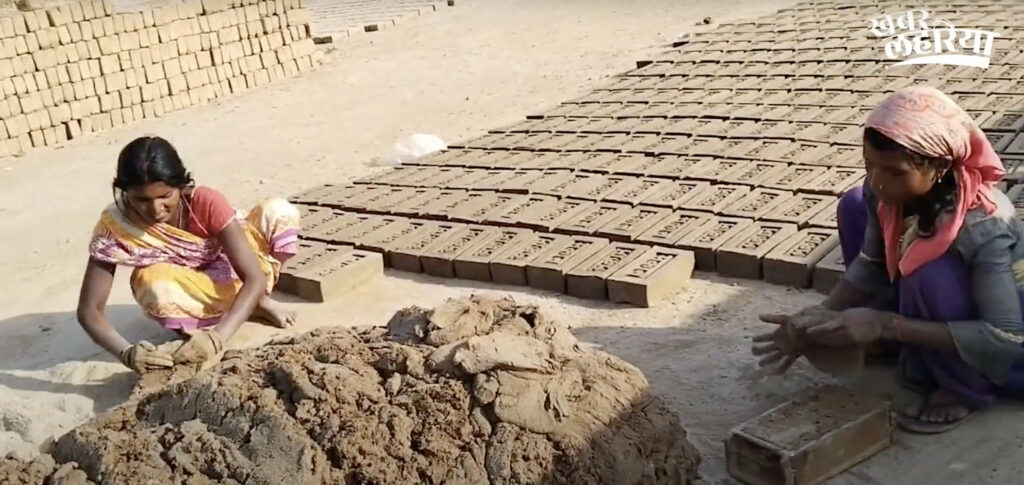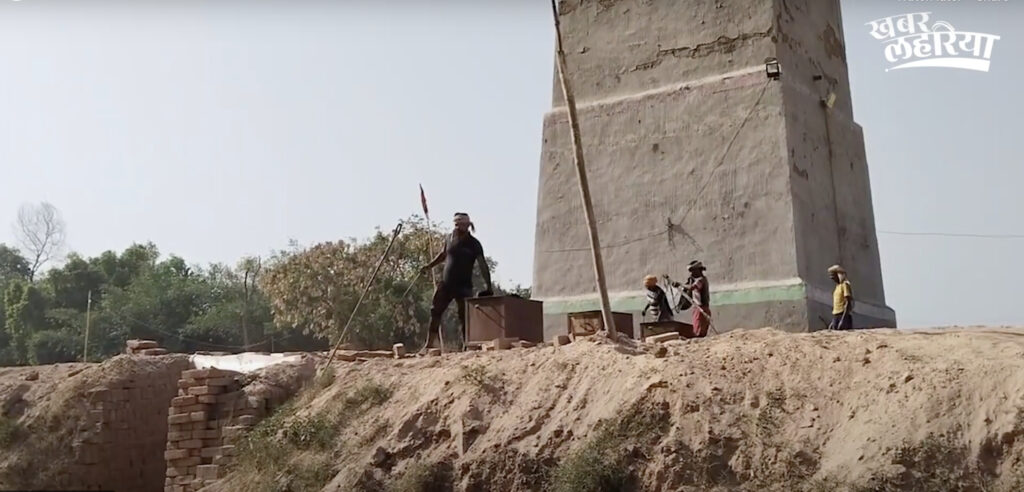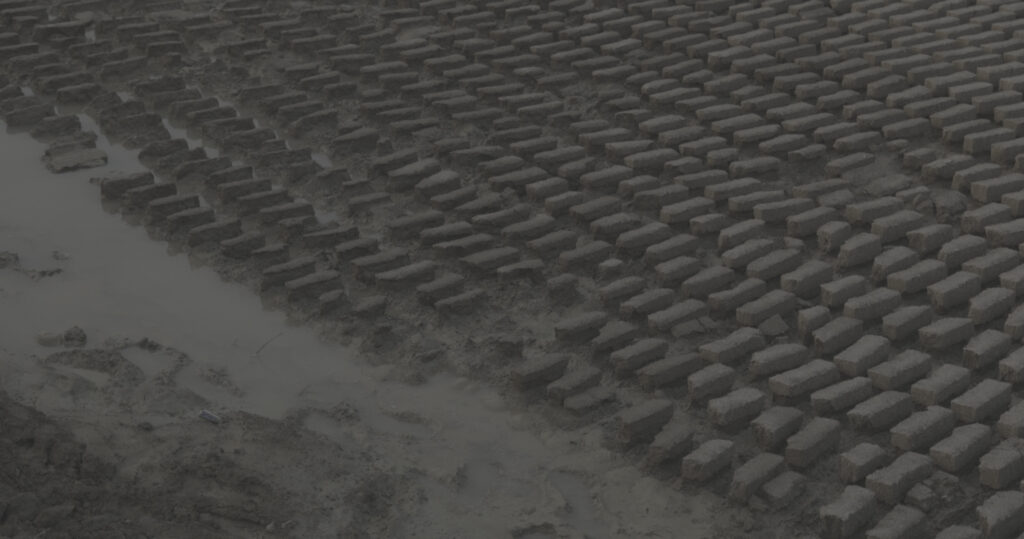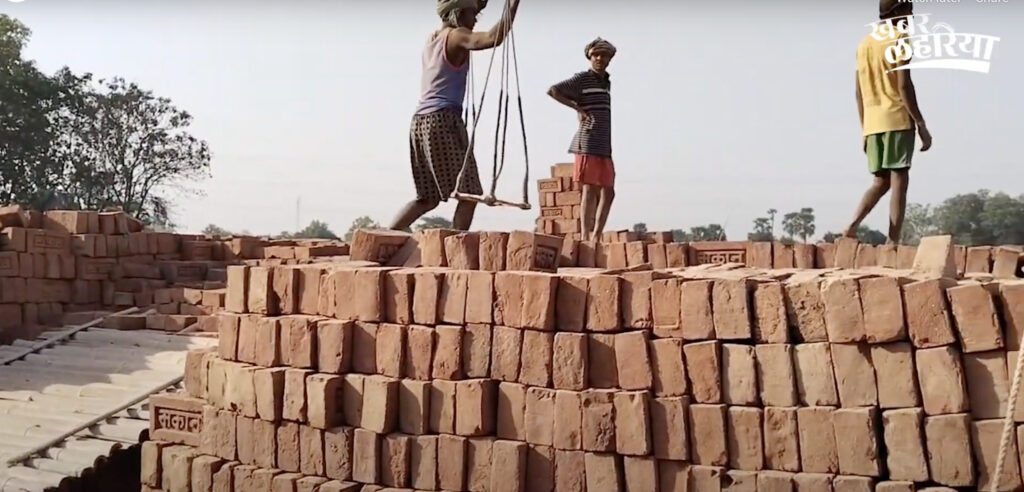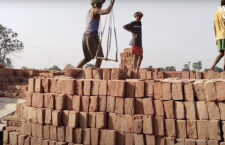Climate change, once a theoretical concept, has become a cruel reality for many around the globe. No sector feels this more acutely than the brick kiln industry in Uttar Pradesh. As industries and economies grapple with the climate crisis, the industry’s struggle to survive serves as a stark reminder of the very real and harsh impact of a changing climate.
For Dwarika Prakash Mor, a seasoned brick kiln owner from Pratapgarh in Uttar Pradesh, irregular weather patterns (signalling climate change) are not a distant threat; they are an immediate and profound challenge. With five decades of experience, he has seen the industry weather many storms. But the changing climate patterns, he attests, have brought unprecedented upheavals.
Brickmaking is deeply entwined with the rhythms of nature. The dipping winter temperatures mark the beginning of the brick-making season, with labourers setting to work to shape and mould the bricks, leaving them to dry in the open air. The summer heralds the firing process, with bricks hardened in kilns before they find their way into various infrastructural projects. However, this predictable cycle has been disrupted, thanks to the changing weather patterns.
The altercations in rainfall patterns in the country indicate climate change. As per reports from the India Meteorological Department (IMD), there has been an excess in rainfall during the non-monsoon months, and deficiency in the same in the monsoon months. There has been a deficiency in rainfall in June. Uttar Pradesh has witnessed a staggering 253% excess rainfall between March 1 and April 3, 2023. This downpour is not just water over the bridge; it has severe consequences on the brick-making process. Traditionally, bricks are left in the open to dry, and unexpected rains can cause severe damage, affecting both their quality and the industry’s economy. These rain patterns wet the chimney, therefore, putting the brick-burning process to a halt. The IMD has also released notifications about the rainfall deficit in the month of June.
Dwarka Prakash Mor speaks of this impact with an air of melancholy. “Rainfall inflicts substantial damage. Bricks don’t dry fast enough, impacting their quality. Labourers can’t work on rainy days, resulting in a season’s loss worth Rs 25,000-30,000. I have to bear losses of 10-15 lakhs bricks per season, which can escalate to 20-25 bricks lakhs if the rainfall is relentless like it has been for the past three years. The economic burden we face is monumental.”
The Climate crisis is a double-edged sword for the brick kiln industry. While the industry is a victim of the climate crisis, it is also a contributor to it. Contributing to 13% of the global output, India stands as the world’s second-largest producer of bricks, manufacturing a staggering 200 billion units annually. This extensive production results in the consumption of approximately 35-40 million tonnes of conventional fuels each year.
The small-scale brick kiln industry, propelled by global urbanization and economic growth, significantly contributes to atmospheric pollution by using conventional burning fuels, lignite, tyres, plastic, etc. and sometimes low-grade carbonaceous materials, which are high in sulphur and ash content, leading to the emission of harmful sulphur dioxide and black carbon.
Dr Girdhari, a member of the Rashtriya Sahaai Sewa Sang, who works at the intersection of environment, women’s issues, and poverty alleviation, points out this paradox. “The side-effects of infrastructural development are leading to climate change. Gases produced by traditional brick-kiln furnaces are contributors to climate change.”
Also Read : Varanasi Brick Kiln Leads A Greener Way With Zig-Zag Technology
Do Alternatives to the Conventional Fuels Exist?
The answer is, yes! In this context, the Uttar Pradesh New and Renewable Energy Development Agency’s (UPNEDA) initiatives present an alternative path. Focusing on harnessing energy from biofuels, bagasse from sugar industries, and urban and industrial waste, UPNEDA’s projects aim to revolutionize energy production and consumption. Transitioning to sustainable energy alternatives in the brick kiln industry could significantly reduce its environmental impact and carbon footprint.
Moreover, UPNEDA has also been harnessing energy from urban and industrial waste through its Biogas-based Power Generation Project and Waste to Energy Project. These projects turn waste into a valuable energy resource, simultaneously addressing waste management issues and energy needs. If integrated into the brick kiln industry, such waste-to-energy approaches could provide a reliable, sustainable energy source for brick firing, reducing the industry’s environmental footprint and dependence on climate-dependent practices.
The above-mentioned initiatives have the potential to make the industry more climate-resilient. By reducing its reliance on weather-dependent processes, the industry could enhance its capacity to withstand erratic weather patterns. This transformation could help stabilize the livelihoods of thousands of labourers who depend on this industry and whose survival is threatened by climatic disruptions and industry volatility.
Livelihoods Impacted, Labourers Falling in Steeper Debts
Heavy rains have inundated fields, ruining millions of bricks, and setting in motion a lengthy and detailed cleanup process. The irregular climatic conditions have also meant that workdays are lost, affecting the livelihoods of the many migrant labourers who depend on this industry.
Dr Girdhari laments, “The intensity of each weather has changed, due to climate change, even giving rise to pandemics like COVID-19. For instance, a lot of times, infrastructural development equates to deforestation, but it needn’t be the case.”
Labourers working in Brick Kilns annually migrate for a period of six to eight months. The workers’ economic conditions compel them into taking debts from the kiln owners via kiln contractors. Additionally, they take on-site obligations for groceries and medicines which are also subtracted from their total earnings. The remainder serves as their savings.
A raw-brick maker from Banda, Ram Pratap has worked as a brick kiln labourer for 17 years. But it’s only recently that he’s begun to run into problems at work. He and his entire family were unemployed for almost two months – 25 days in January and 25 days in March. The reason? An unusual and sudden onset of heavy rainfalls.
“Without rainfall, we earn Rs 70,000 to a lakh in one season. But I’ve been idle for two months this year due to poor weather. We had made 2 lakh bricks. All of them got destroyed in the rain.” His words echo the sentiments of countless others who find themselves at the mercy of this problem.
Ram Pratap’s narrative elucidates the cascading effects of these disruptions – the mounting debts, the uncertainty about the future, and the crushing helplessness. Pratap earned Rs 500 per 1000 bricks. He said, “This wage isn’t enough to support me and my family, but I had no choice. However, this time, we have merely saved Rs 10,000 at the end of the season. I’m a poor man, and I must endure this.”
While the workers were waiting for the work to restart, their onsite debts kept increasing. “Just because we are out of work, we can’t stop eating food, we have to keep taking debts for everyday living,” he says.
Recent temperatures recorded in nearby districts like Ballia – 43 degrees have alarmed its inhabitants, aggravating the heat further with increased humidity. He adds, “Working in extreme weather conditions – summer or winter, often makes us sick. Then, we have to depend on private clinics.”
A union worker, Ram Prakash Pankaj, highlights the societal cost of the climate crisis on this workforce. “The brick kiln labourers are largely migratory, with their children often bearing the brunt of their nomadic lifestyle. Access to consistent education becomes a pipe dream for these children, their futures wavering with every shift in location.”
He adds that the existing government compensation schemes need to adequately address the gravity of the situation. “For 40 lakh labourers, the government is compensating them with just 20 lakhs.” His plea for increased financial support and safety schemes is a testament to the need for policy changes that consider the changing realities.
Ram Prakash Mor calls for stricter government interventions to the economic impact Brick Kilns have had to suffer. “We pay substantial taxes – fuel, labour – to the zila parishad, but we don’t receive any subsidy in return,” Mor, laments. His plea underscores the necessity for government intervention and the need for technology adoption to mitigate these challenges. “We’d like to see subsidies in fuel, easier access to loans, and insurance for our furnaces.”
Also Read : Building a Better Future: The Role of Training in Elevating Brick Kiln Workers
Initiating Measures Which Bring About a Holistic Change
In the face of these challenges, the advent of climate change presents an opportunity – to reimagine and reinvent the brick kiln industry for a future that benefits all the stakeholders working – from the Brick Kiln owners to labourers. As we pursue progress, it is vital that these bricks stand not just as building blocks of structures, but also of resilient societies.
The International Growth Centre (IGC) advocates for a holistic approach that addresses the immediate climate impact on industries like brick kilns and the long-term health and environmental implications of such industries. The pollution caused by Brick Kilns lead to respiratory issues and a decline in lung function. According to a document released by the World Bank titled – ‘Dirty Stacks. High Stakes’, brick kiln contamination was strongly linked to the impaired pulmonary function observed in labourers.
The document also suggested that other than respiratory issues, Brick kiln workers face a variety of hazardous occupational exposures, including chemical, physiological, and physical hazards. Workers are exposed to high concentrations of brick dust, silica and combustion productions, including PM. These exposures have been linked to an increased risk of cancer and potentially Anaemia. Additionally, frequent repetitive motion and heavy load transportation make workers at higher risk for musculoskeletal disorders.
Ram Pratap, who is a familiar survivor, says he prefers private over public healthcare and doesn’t believe any of the government’s health schemes are beneficial. “It has a lot to do with trust,” he says. “If I’m paying more than the government hospital rate, it’s only because I know the doctors won’t treat me or my family like an animal. We don’t have any provisions under our own state, so expecting from another is far-fetched. This is the reality of migrants here. Even our kiln owner doesn’t pay for our treatment.”
While the environmental crisis has undeniably brought challenges to industries like brick kilns, it also offers an opportunity. By leveraging UPNEDA’s biofuel projects and reducing reliance on traditional, pollutant-heavy fuels, the industry can adapt to the changing climate and mitigate its environmental impact.
As Dr Girdhari aptly puts it, “We need ethical practices and intentions with the understanding that this is tied to our very survival. Such practices shield workers from toxic fumes and the constant heat, thereby preventing illnesses.” According to him, revolutionising the brick kiln industry requires changes at every step of the way. He states, “Switching to more sustainable methods requires a systemic overhaul of our current understanding of the climate. Farmers, for instance, should abstain from burning crop residues and adopt technology instead. The same principle applies to the brick kiln industry, where multiple furnaces within a small radius severely degrade air quality.”
A slightly more environmentally friendly method being increasingly used in the brick kiln industry is Zig-Zag.This method has already proven to be effective as it requires much less energy consumption as compared to the traditional kilns.
According to the World Bank report of 2020, stronger policy frameworks are needed to tackle the pollution being caused by Brick Kilns. The report says, “While air pollution has taken centre stage in policy discourse in South Asia, there are few or absent policy and regulatory frameworks, particularly those that target air pollution arising from artisanal and traditional brick production technologies.”
Brick production in India is primarily concentrated in peri-urban or rural areas which ends up shadowing it from the policy making process that’s often confined to big cities. Various regulatory bodies have controlled the problems of air pollution through impositions of bans or shutting down the kilns altogether, leading to large scale job losses. Policy frameworks need to consider the social protection of workers while making policies.
Adopting sustainable practices in the brick kiln industry offers immediate and tangible benefits for the workforce. Improved air quality, resulting from reduced emissions, directly addresses the significant health risks associated with traditional brick kiln operations, potentially decreasing the incidence of respiratory diseases among workers. Simultaneously, the promise of more secure and better-paid employment could significantly enhance the socio-economic condition of these migrant labourers, ushering in a new era of stability and prosperity for this vulnerable community.
This story is part of a media series under Buniyaad, a movement towards a foundational change for a just transition in the brick kln sector, where we will bring social, economic and environmental stories related to equitable change in the brick kiln industry of Uttar Pradesh.
The main objective of this campaign is to work with brick kiln owners, workers, organizations, technical experts and government policy makers to find clean technology for the industry, which can reduce environmental pollution and center and ensure societal welfare benefits for individuals and communities associated with the industry. The Climate Agenda, 100% Uttar Pradesh Network and Chambal Media are a part of this campaign.
This article is written by Hameeda Syed.
‘यदि आप हमको सपोर्ट करना चाहते है तो हमारी ग्रामीण नारीवादी स्वतंत्र पत्रकारिता का समर्थन करें और हमारे प्रोडक्ट KL हटके का सब्सक्रिप्शन लें’
